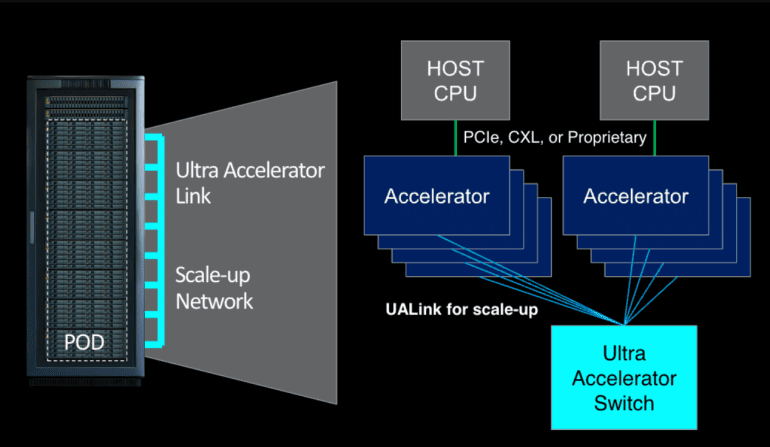- Leading tech companies, including Intel, Google, Microsoft, and Meta, establish the Ultra Accelerator Link (UALink) Promoter Group.
- The consortium aims to standardize AI accelerator chip integration in data centers, with AMD, Hewlett Packard Enterprise, Broadcom, and Cisco also participating.
- UALink 1.0 proposes a standard to connect up to 1,024 GPUs within a computing “pod,” promising improved speed and reduced latency.
- The UALink Consortium will oversee ongoing development, with UALink 1.1 set to debut in Q4 2024.
- Notable absence of Nvidia underscores competitive dynamics, while AWS’s cautious approach reflects strategic considerations.
- Major players like Microsoft, Meta, and Google stand to benefit from diversifying their hardware ecosystems amid rapid market growth.
Main AI News:
Tech industry leaders have united to form a consortium aimed at advancing the development of next-generation AI chip components. Spearheaded by Intel, Google, Microsoft, Meta, and other influential players, the Ultra Accelerator Link (UALink) Promoter Group is set to pave the way for the integration of AI accelerator chips in data centers.
This initiative, unveiled on Thursday, marks a significant step forward in establishing a standardized framework for connecting AI accelerator chips within server infrastructures. With notable members such as AMD, Hewlett Packard Enterprise, Broadcom, and Cisco onboard, the UALink Promoter Group aims to foster innovation and collaboration in the burgeoning AI hardware landscape.
“The industry needs an open standard that can be advanced rapidly, fostering an ecosystem where multiple companies can contribute value,” emphasized Forrest Norrod, AMD’s GM of data center solutions, during a press briefing on Wednesday. “We require a standard that promotes innovation unhindered by any single entity.”
The proposed standard, UALink 1.0, is designed to facilitate the seamless connection of up to 1,024 AI accelerators, specifically GPUs, within a single computing “pod.” Leveraging open standards like AMD’s Infinity Fabric, UALink 1.0 promises enhanced speed and reduced data transfer latency compared to existing interconnect specifications.
Looking ahead, the UALink Consortium is slated to be established in Q3 to oversee the ongoing development of the UALink specification. Companies joining the consortium will gain access to UALink 1.0, with an upgraded UALink 1.1 featuring higher bandwidth set to debut in Q4 2024. Initial UALink products are expected to hit the market within the next few years, according to Norrod.
However, notable absences from the consortium, such as Nvidia, underscore the complex dynamics within the AI hardware landscape. With Nvidia dominating a significant share of the market, its reluctance to embrace a standard based on rival technologies is understandable. Moreover, Nvidia’s formidable position in the industry affords it considerable autonomy in charting its course.
Meanwhile, Amazon Web Services (AWS), another key player, has yet to commit to the UALink initiative. As AWS continues to refine its in-house accelerator hardware efforts, its stance reflects a strategic calculus shaped by its market position and ecosystem dynamics.
Despite these challenges, the UALink initiative holds significant promise, particularly for major players like Microsoft, Meta, and Google. With substantial investments in AI infrastructure, these companies seek to diversify their hardware ecosystems and reduce dependency on dominant vendors.
In light of projections by Gartner forecasting exponential growth in the AI accelerator market, the strategic significance of initiatives like UALink cannot be overstated. As technology giants vie for supremacy in the AI hardware landscape, the path forward will be defined by collaborative efforts and innovative standards that drive the industry forward.
Conclusion:
The emergence of the UALink initiative signifies a collaborative effort among tech giants to standardize AI hardware components. While challenges remain, particularly with key players like Nvidia and AWS yet to fully commit, initiatives like UALink pave the way for increased innovation and competition in the AI hardware market. As major companies seek to reduce dependency on dominant vendors and foster ecosystem diversity, the stage is set for a dynamic and transformative phase in the AI hardware landscape.

